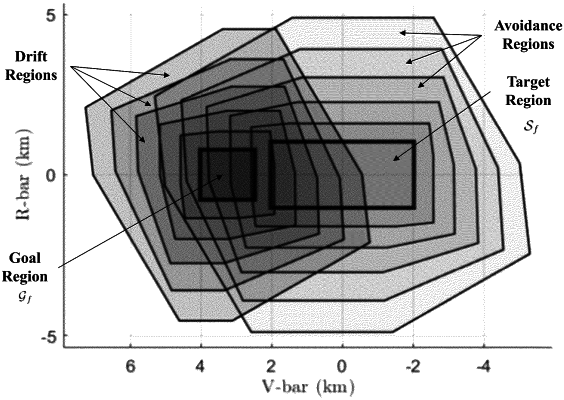| CPC B64G 1/242 (2013.01) [B64G 1/368 (2013.01); B64G 2001/247 (2013.01)] | 21 Claims |

|
8. A drift-based rendezvous control system for controlling an operation of a spacecraft to rendezvous the spacecraft with a target over a finite time horizon, comprising:
a transceiver configured to accept data including values of spacecraft states and target states of the target in a multi-object celestial system at a specified time period within the finite time horizon;
a processor at the specified time period configured to:
access a memory having stored a target region database and a goal region database, where a goal region is outside a target region;
select a set of avoidance regions corresponding to a desired target region at a location on an orbit where the target is located at the specified time period, wherein the set of avoidance regions represents regions of space around the desired target region guaranteeing intersection trajectories with the desired target region, in an event of total or partial spacecraft thruster failure;
select a set of drift regions corresponding to a desired goal region in proximity to a location on an orbit where the target is located at the specified time period, wherein the set of drift regions represents regions of state space around the desired goal region that guarantee spacecraft thruster free operation to reach the desired goal region, wherein each of the regions of state space around the desired goal region comprise a position and a velocity of the spacecraft;
formulate the set of avoidance regions as constraints;
update a controller having a model of dynamics of the spacecraft with the accepted data;
formulate the set of drift regions as a penalty in a cost function of the updated controller;
generate control commands by subjecting the updated controller to the constraints to generate control commands that result in a real-time drift-based control policy producing a collision free rendezvous trajectory which avoids the set of avoidance regions, guaranteeing an intersection-free trajectory with respect to the desired target region in the event of the total or partial spacecraft thruster failure and upon the spacecraft entering the set of drift regions the thrusters are turned off in order to minimize an amount of operation of the thrusters while rendezvousing with the target; and
output the control commands to activate or not activate one or more thrusters of the spacecraft for the specified time period based on the control commands.
|